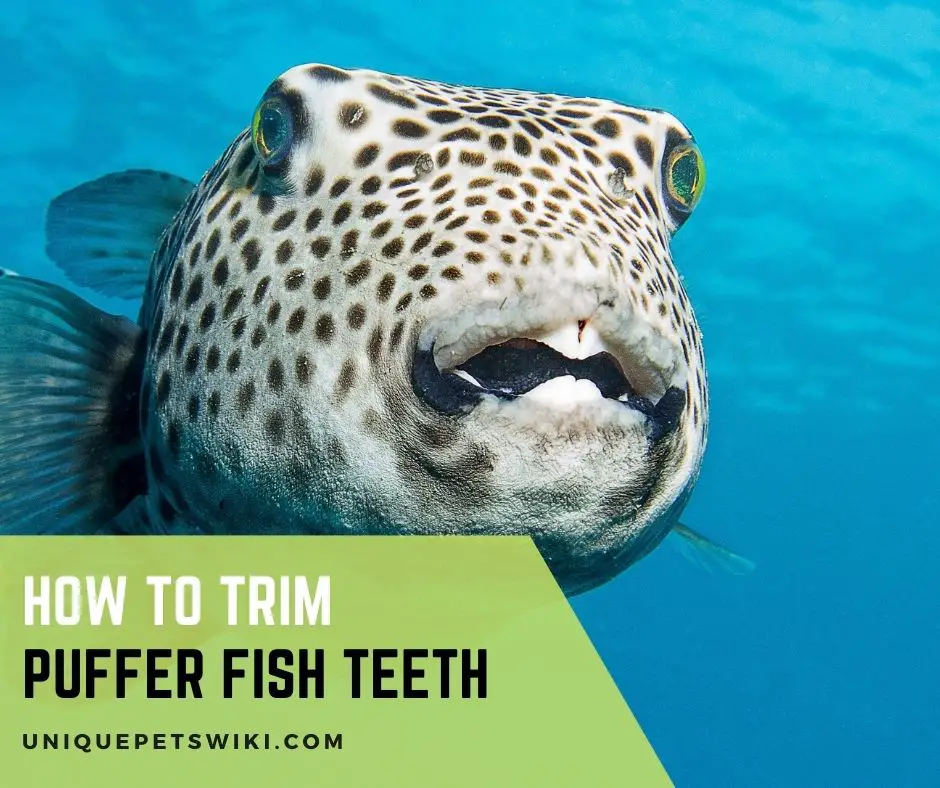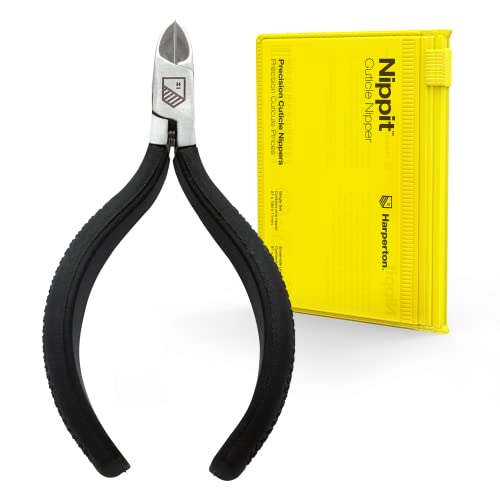One of the responsibilities of pufferfish owners is taking care of their ever-growing teeth. Thus, knowing how to trim pufferfish teeth is necessary for every owner.
Untrimmed teeth are likely to overgrow to the point that your pufferfish pet cannot open its mouth wide enough to eat. Nibbling food will be a challenge, jeopardizing the fish’s health.
Trimming the teeth of your pufferfish requires you have the requisite knowledge about the process. This article contains an in-depth discussion of the pufferfish teeth cutting procedures and how you can prevent the teeth from growing overly.
Contents
Do Puffer Fish Need Their Teeth Trimmed?
Yes, it is wise to trim pufferfish teeth to maintain them in a perfect shape where the fish will not struggle to eat. Many fish species have teeth that stop growing at some time in the future, but pufferfish is an exception.
Their teeth constantly develop throughout their life like the teeth of rodents, hence creating the need to trim them often.
The wild species continuously wear their teeth by eating hard-shelled foods, but pufferfish pets are vulnerable to overgrown teeth problems because of the soft captive diet.
If your pufferfish don’t get hard meals, trimming will be inevitable. Otherwise, the most significant way to ensure proper teeth care and dental health is by providing your fish pet with a diet filled with crunchy fish foods.
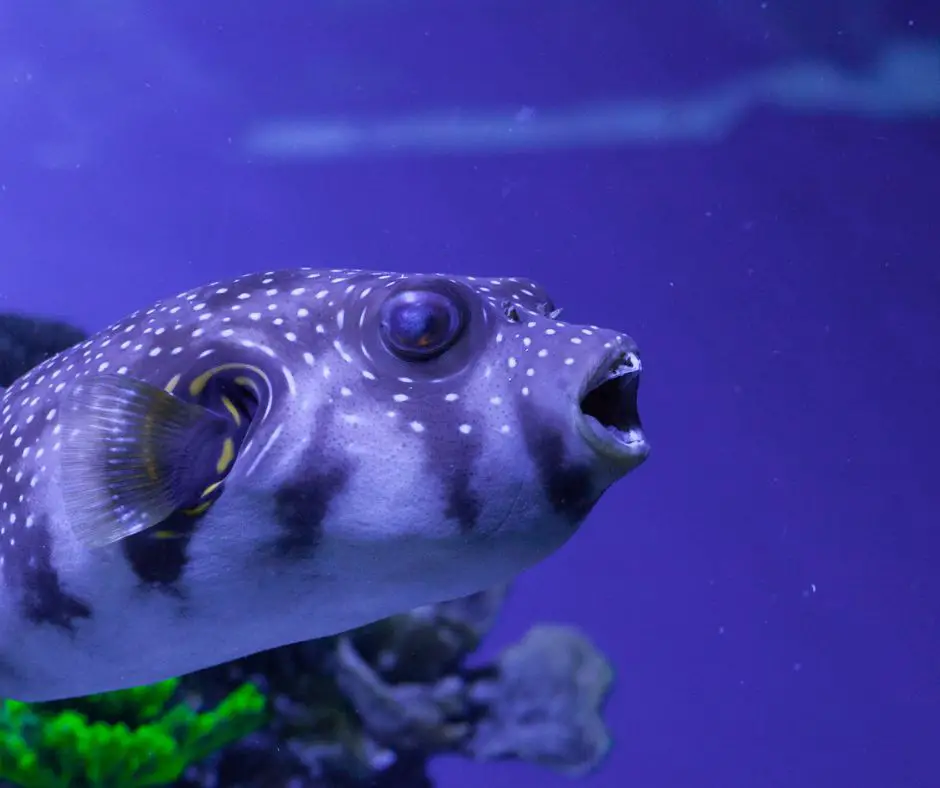
How to Trim Puffer Fish Teeth
If your pufferfish teeth are already overgrown, giving hard meals will not grind the teeth down. They need to be cut to obtain a proper shape.
When it comes to clipping pufferfish teeth, cuticle clippers work best than nail clippers. The former has a better handle, and with its style, it makes trimming simple.
Cuticle clippers are ideal for clipping small pufferfish teeth, but it’s best to use a hobby-sized rotary tool with a buzz saw blade if you’re dealing with a larger pufferfish.
Trimming pufferfish teeth is a simple process, and it will not cost much of your time, but it’s something you should do with extreme caution. Below are six steps to trim pufferfish teeth.
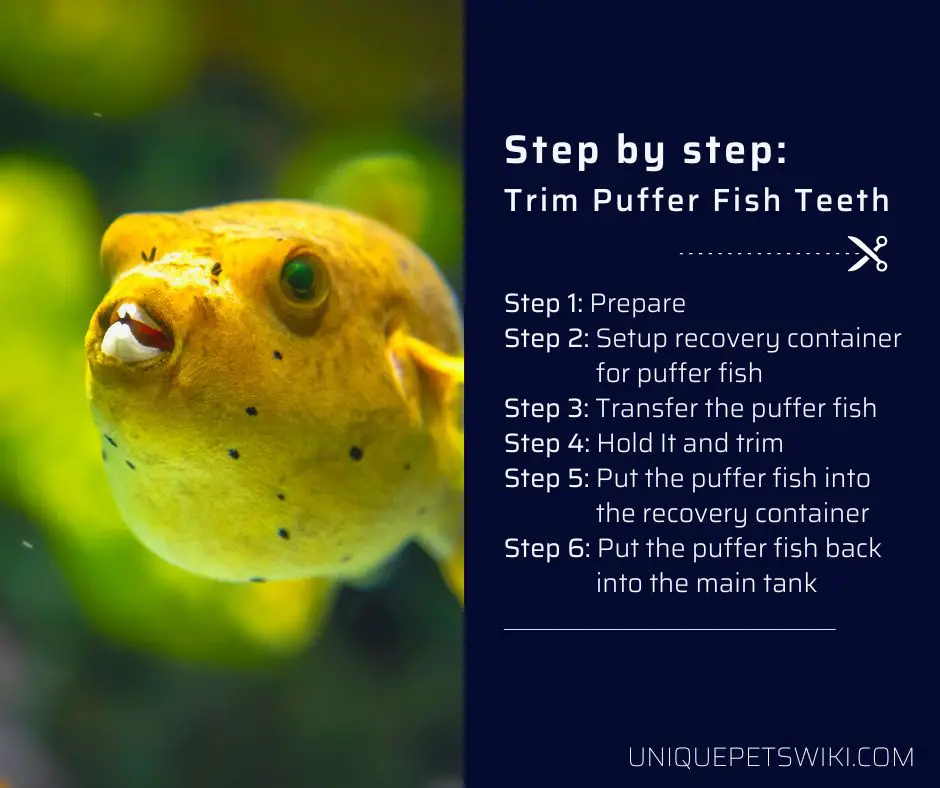
Step 1: Prepare
First, identify the tools and materials to use and put them together. It’s necessary to prepare everything and ensure it is within your reach to avoid any disruption when you start trimming.
Materials Needed;
- Two containers (one-quart each)
- Clove oil
- Gloves
- A new set of cuticle clippers or cutting pliers
- Airstone and pump
- SeaChem Prime water conditioner
Step 2: Setup Recovery Container for Puffer Fish
Setup a recovery container in advance of the trimming, and this is where you will tranquilize your puffer pet. It’s easier to work on a tranquilized fish, and trimming becomes less stressful.
Some people would avoid sedating their fish, but the problem is that the puffer can squirm during clipping and cause you to hurt it undeliberately, especially on the lips.
Take the two containers we prepared and fill each with three cups of tank water. Alternatively, you can prepare dechlorinated water using SeaChem prime water conditioner and use it in-place-of tank water.
Carefully put three drops of clove oil in one container to tranquilize the fish. Note, this will serve a pufferfish under 4-inches long. Get the correct dosage to use from your vet since this varies depending on the size of the fish.
The second container will be our recovery container. Airstone so that the pufferfish will get a place to relax before putting it back in the tank after it’s trimmed.
Plastic Round Food Storage Container
- QUALITY ENGINEERING - Its commercial grade, break-resistant, polypropylene material allows for greater durability, product visibility, and a smooth surface, allowing for easy cleaning.
- DESIGNED FOR AIR CIRCULATION - Round containers promote increased air circulation around the container and allow for quicker cooling times.
- TEMPERATURE RANGE - Made of FDA compliant materials, this food storage container is dishwasher safe and able to withstand temperatures from 35 to 150 degrees Fahrenheit.
- IDEAL FOR FOOD PREP - These containers come in a wide variaty of measured sizes, allowing perfect portion control for any diet or meal
- PERFECT SIZE FOR - Large serving meal prep, coffee beans, smaller produce items like Cherry Tomatoes, Salad mix, cut Broccoli, Garlic, Asparagus, Limes
Last update on 2022-12-29 / Affiliate links / Images from Amazon Product Advertising API
Step 3: Transfer the Puffer Fish
Scoop the fish from its tank with a net, cover the top of the net with your hand to prevent your pet from wriggling out, and be extremely gentle. If you have many puffers, try to transfer one at a time.
Submerge the net in the container with the clove oil and allow the puffer to swim out on its own, or you can give a little assistance. But don’t upturn the net to let the fish plop.
The puffer will roll on its side and lay on its back in the container within one minute. The fish will appear dead, which is entirely normal, so it shouldn’t give you a shock.
Your pet is just sedated, and it will be fine. Likewise, sedation also slows down gill movement, and the tranquilized fish is holding its breath; hence, you need to clip the teeth as quickly as possible.
Step 4: Hold It and Trim
Pick the puffer out of the container with a net and hold it through with the same net. It’s essential to support the fish with a net so that you don’t harm its skin with the oil from your hand.
You can hold the puffer with one hand and use your other hand to do the clipping. Peel back the net to expose the fish’s head and teeth, and clip the teeth with a cuticle clipper.
Try to be quick but gentle, not to cut the puffer’s mouth or lips. Clip the teeth straight across and as short as possible. If both the upper and lower teeth are overgrown, clip all of them, but separately.
Harperton Cuticle Trimmer
- Precise: The Nippit Cuticle clipper is constructed from extra fine surgical-grade stainless steel and sharpened to perfection acting as an excellent nail cuticle trimmer.
- Ergonomic: Easy to hold rubber grips ensures the Nippit professional cuticle remover will cut where you need to without fear of losing control while nipping damaged cuticles.
- Compact: Measuring 2.5 x 5 inches, the Nippit Cuticle tool makes a great addition to an existing nipper set or manicure pedicure travel kit.
- Pedicure Manicure Tool: It’s a must have tool in nail care kit for both Men and Women, multi-purpose nail cuticle remover tool is great for nail art learner,pro nail tech,salon,home, travel DIY nail art and personal care.
- Guaranteed: As with all Harperton tools, the Nippit comes with a 100% Satisfaction Guarantee and Lifetime Replacement Warranty means your purchase is protected by Amazon and backed by Harperton.
Last update on 2022-12-29 / Affiliate links / Images from Amazon Product Advertising API
Step 5: Put the Puffer Fish into the Recovery Container
After trimming, put the pufferfish into the recovery container, where we had the Airstone. The fish will recover after a minute, and you will see it swimming around the container within two minutes.
The fish should start eating within a few hours if everything went well. You can then comfortably transfer it to the tank.
Step 6: Put the Puffer Fish Back into the Main Tank
Put your fish pet back into the main tank using a net. Keep an eye on the fish for a while to ensure it’s completely okay.
After around two hours later, the fish should be swimming as if nothing had happened. It will be active and eating should not be a problem.
Remember that pufferfish teeth clipping at home should only be done when your pet is small. To clip larger fish species require you to get a second person’s help or seek a veterinary service.
You can also get the service from your local aquarium club if they have experience doing this kind of work. Home trimming requires the puffer to be larger than one inch and less than 2-4 inches.
How Often to Trim Puffer Fish Teeth?
There is no exact answer about how often you can trim pufferfish teeth, as the operation depends on a number of factors, including the diet fed and the type of pufferfish.
Pufferfish that experience problems with overgrown teeth are those under improper diet. These pets show a great appetite for softer meals over hard food, but you should try by all means to limit softer meals.
Ideally, they would need their teeth clipped every three months when without enough hard-shelled meals, e.g., snails, offered to pufferfish.
That is because such puffers don’t have foods that will help them maintain their teeth trimmed. But if your puffer has hard-shelled foods available most frequently, trimming will not be a frequent thing.
What Happens If You Don’t Trim Puffer Fish Teeth?
Pufferfish teeth grow consistently and might overgrow sufficient to make it impossible for these pets to feed themselves.
A puffer with overgrown teeth may try to eat but end up spitting back the food. The teeth can extend so far forward that the upper and lower jaws cannot come together to crush food.
You can be sure that at this point, the fish cannot eat even the soft foods, which will eventually cause starvation.
How to Prevent Puffer Fish Teeth from Overgrowing
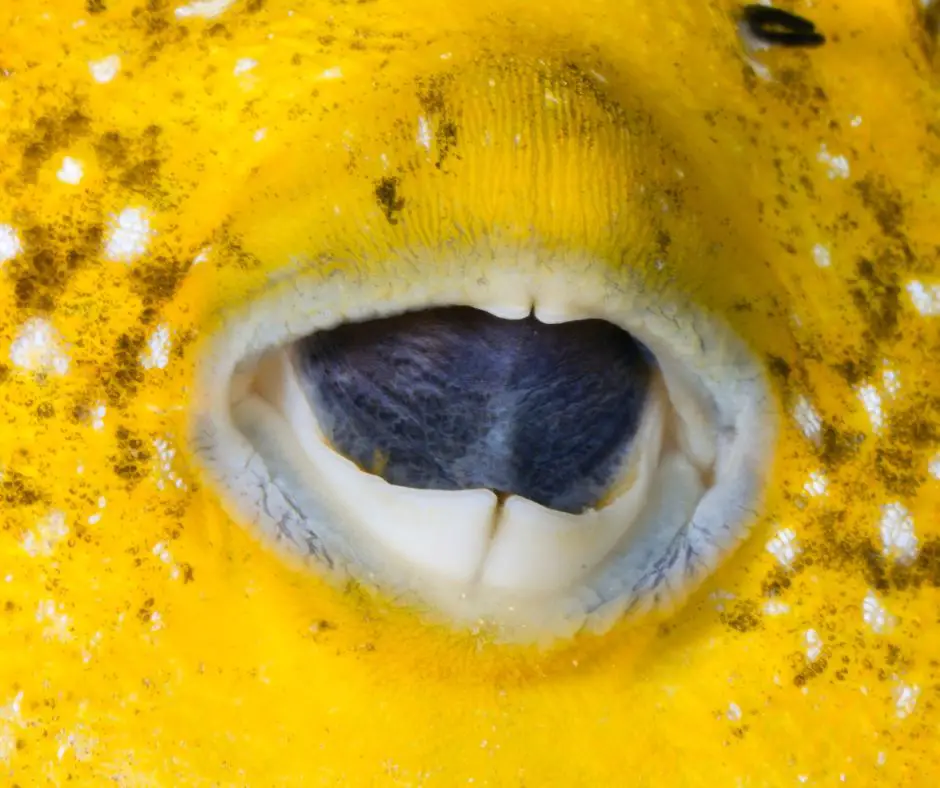
The surest way to ensure good teeth care and dental health in pufferfish is to provide them with a diet rich in crunchy fish foods.
Know the size of your pufferfish since it will help you feed fish food of appropriate size. For instance, freeze-dried krill and small snails are ideal for helping smaller puffers wear their teeth.
The bigger puffers have many extra crunchy meals for exercising their teeth, including mussels, crayfish, shrimp, oysters, etc.
Animals with Fast-Growing Teeth
Like puffers, many animals, such as rabbits, rodents, sharks, etc., have a dentition that constantly regenerates in their entire life.
If we major on pufferfish, the freshwater species of these animals whose teeth develop fast are the South American and the two Asian green bottle pufferfish. These species will develop overgrown teeth even after attempting to regulate their diet.
The bigger marine pufferfish are also likely to develop overgrown teeth, including Diodon holacanthus and Diodon hystrix. All arothron species, where we have arothron hispidus and Arothron nigropunctatus, have fast-growing teeth too.
Moreover, spiny pufferfish/porcupinefish have teeth that grow constantly. All these species may require teeth care and dental work every so often.
Conclusion
Hopefully, you found insightful information in this article. You now know that pufferfish have endlessly growing teeth, and they are likely to overgrow and cause problems if there is nothing to wear them.
Owners need to subject their puffers to many hard foods to provide them with something for exercising the teeth. Without trimming, the teeth can overgrow, sufficient to make the fish starve or even die.
Don’t forget that trimming puffers require extreme caution and that you use appropriate tools. However, if you’re not 100% confident about trimming your puffer, it’s necessary to let an experienced person do it for you, e.g., your vet.
